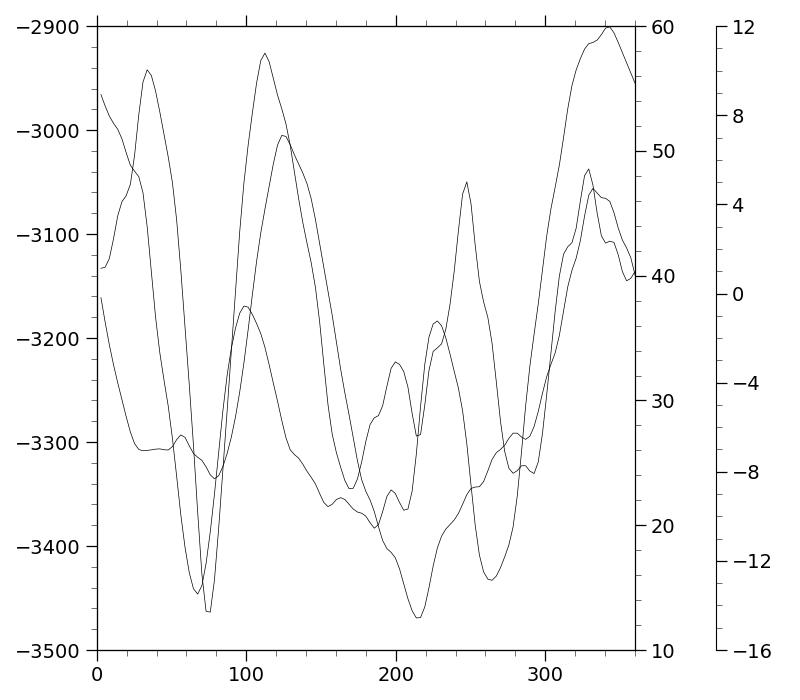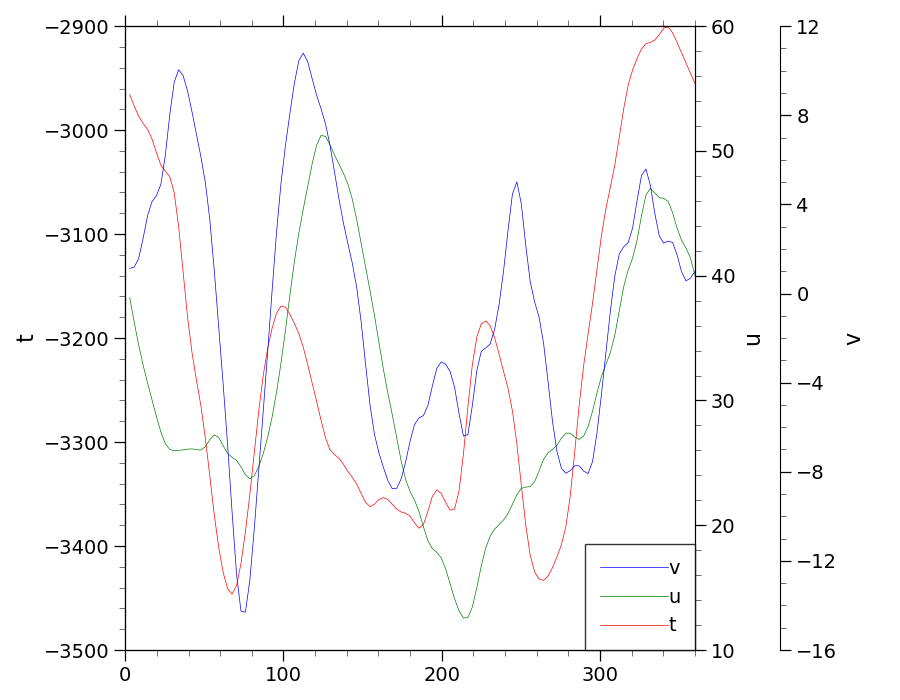Note
Click here to download the full example code
NCL_xy_19.py¶
- This script illustrates the following concepts:
Drawing an XY plot with three different Y axes
Drawing a custom legend inside an XY plot
- See following URLs to see the reproduced NCL plot & script:
Import packages:
import matplotlib.pyplot as plt
import numpy as np
import geocat.datafiles as gdf
from geocat.viz import util as gvutil
Read in data:
# Use numpy loadtext function to unpack data from ascii file
lon, u, v, t = np.loadtxt(gdf.get("ascii_files/xy.asc"), unpack=True)
# Do some unit conversions
lon = lon * 360 / 128
t = (t - 273.15) * 9 / 5 * 32
Helper function to format the axes
def make_axes(plot_size):
fig, ax1 = plt.subplots(figsize=plot_size)
ax2 = ax1.twinx()
ax3 = ax1.twinx()
# Offset the 3rd axes
ax3.spines['right'].set_position(('axes', 1.15))
# Use geocat.viz.util convenience function to add minor and major tick lines
gvutil.add_major_minor_ticks(ax1, y_minor_per_major=5, labelsize=14)
gvutil.add_major_minor_ticks(ax2, y_minor_per_major=5, labelsize=14)
gvutil.add_major_minor_ticks(ax3,
x_minor_per_major=5,
y_minor_per_major=4,
labelsize=14)
# Use geocat.viz.util convenience function to set axes tick values
gvutil.set_axes_limits_and_ticks(ax1, ylim=(-3500, -2900))
gvutil.set_axes_limits_and_ticks(ax2, ylim=(10, 60))
gvutil.set_axes_limits_and_ticks(ax3,
xlim=(0, 360),
ylim=(-16, 12),
xticks=[0, 100, 200, 300],
yticks=np.arange(-16, 13, 4))
# Adjust which sides of the plot the tick marks are drawn for each axes
ax1.tick_params('both', which='both', right=False)
ax2.tick_params('both', which='both', bottom=False, top=False, left=False)
ax3.tick_params('both', which='both', bottom=False, top=False, left=False)
return ax1, ax2, ax3
Plot the basic figure:
ax1, ax2, ax3 = make_axes((8, 7))
# Plot the data
ax1.plot(lon, t, linewidth=0.5, c='black')
ax2.plot(lon, u, linewidth=0.5, c='black')
ax3.plot(lon, v, linewidth=0.5, c='black')
plt.tight_layout()
plt.show()

Plot the figure with colored lines and add axes labels
ax1, ax2, ax3 = make_axes((9, 7))
# Use geocat-viz.util convenience function to set y axes labels
gvutil.set_titles_and_labels(ax1, ylabel='t')
gvutil.set_titles_and_labels(ax2, ylabel='u')
gvutil.set_titles_and_labels(ax3, ylabel='v')
# Plot the data
ax1.plot(lon, t, linewidth=0.5, c='r')
ax2.plot(lon, u, linewidth=0.5, c='g')
ax3.plot(lon, v, linewidth=0.5, c='b')
plt.tight_layout()
plt.show()

Plot the figure with colored lines, axes labels, and a legend
ax1, ax2, ax3 = make_axes((9, 7))
# Use geocat-viz.util convenience function to set y axes labels
gvutil.set_titles_and_labels(ax1, ylabel='t')
gvutil.set_titles_and_labels(ax2, ylabel='u')
gvutil.set_titles_and_labels(ax3, ylabel='v')
# Plot the data
# axes.plot() returns a list of Line2D object. The line objects can be used as
# the `handles` for the legend. Since we only want the line objects, a comma is
# added after t_plot to extract the first item of the list returned by
# axes.plot()
t_plot, = ax1.plot(lon, t, linewidth=0.5, c='r', label='t')
u_plot, = ax2.plot(lon, u, linewidth=0.5, c='g', label='u')
v_plot, = ax3.plot(lon, v, linewidth=0.5, c='b', label='v')
# Add a legend using the Line2D objects from before as the handles
plt.legend(loc='lower right',
fancybox=False,
edgecolor='black',
borderaxespad=0,
borderpad=0.75,
handlelength=3.5,
handletextpad=0,
fontsize=14,
handles=[v_plot, u_plot, t_plot])
plt.tight_layout()
plt.show()

Total running time of the script: ( 0 minutes 1.276 seconds)